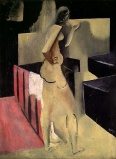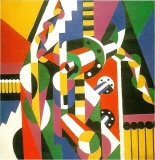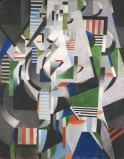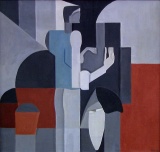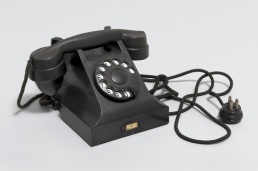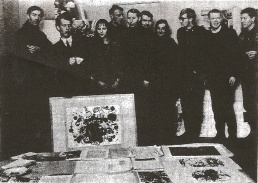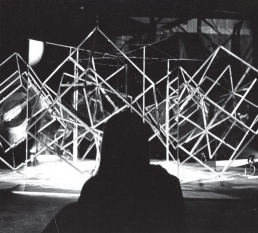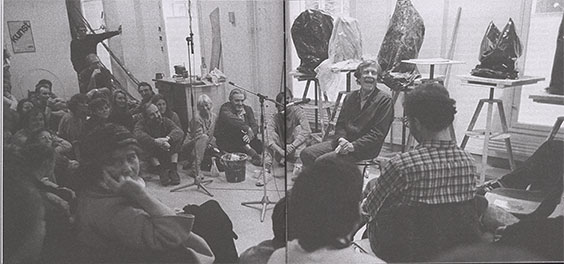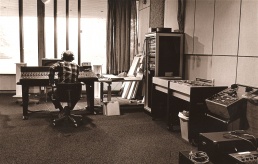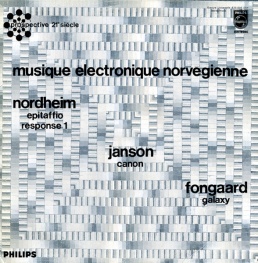Difference between revisions of "Norway"
| Line 13: | Line 13: | ||
==Avant-garde== | ==Avant-garde== | ||
| − | ===Cubist and constructivist painting=== | + | ====Cubist and constructivist painting==== |
[[Image:Academie_Moderne_exhibition_opening_June_1926_Paris.jpg|thumb|258px|Left to right: Standing: Ragnhild Kaarbo and Ragnhild Keyser, sitting: Franciska Clausen, Florence Henri, Ursula Vehrigs, Marcelle Cahn and Hauser. On the occasion of Académie Moderne exhibition opening, June 1926, Paris. [http://www.vehrigs.de/] ]] | [[Image:Academie_Moderne_exhibition_opening_June_1926_Paris.jpg|thumb|258px|Left to right: Standing: Ragnhild Kaarbo and Ragnhild Keyser, sitting: Franciska Clausen, Florence Henri, Ursula Vehrigs, Marcelle Cahn and Hauser. On the occasion of Académie Moderne exhibition opening, June 1926, Paris. [http://www.vehrigs.de/] ]] | ||
[[Image:Keyser_Ragnhild_1925_Peinture_Bilde.jpg|thumb|258px|''Peinture/Bilde'', 1925. [http://www.lillehammerartmuseum.com/?p=4803] ]] | [[Image:Keyser_Ragnhild_1925_Peinture_Bilde.jpg|thumb|258px|''Peinture/Bilde'', 1925. [http://www.lillehammerartmuseum.com/?p=4803] ]] | ||
| Line 30: | Line 30: | ||
</gallery> | </gallery> | ||
| − | ===Jean Heiberg's bakelite telephone design=== | + | ====Jean Heiberg's bakelite telephone design==== |
[[Image:Heiberg_Jean_1932_Ericsson_DBH_1001_Bakelite_Telephone.jpg|thumb|258px]] | [[Image:Heiberg_Jean_1932_Ericsson_DBH_1001_Bakelite_Telephone.jpg|thumb|258px]] | ||
[[Jean Heiberg]] lived in Paris in 1905-12. He got acquainted with Fauvism and Cubism, and was the first of a number of Norwegian painters who studied under [[Henri Matisse]] (1908-10). He is also known for one work in industrial design: when he returned to Norway in 1929, he was commissioned to design a bakelite telephone terminal for Elektrisk Bureau (up till then, telephones had been made out of metal; bakelite was invented in 1909 by Leo Baekeland). Heiberg had produced the huge painted plaster prototype, however it proved to be too difficult to cast in bakelite; the later model had smooth surface and sharp edges. The phone went into production in 1932 as the Ericsson model DBH 1001, and is claimed as the world's first "hookless" bakelite telephone, that is the first telephone where the cradle, or receiver hook, was integrated into the all-bakelite body. The engineering design of this model was made by [[Johan Christian Bjerknes]]. The model was sold throughout Scandinavia, in Britain, Italy, Greece and Turkey, and (through Siemens) in France and the USA; staying in production for over twenty years. See also [http://sales.arte.tv/detailFiche.action?programId=1083 25 min documentary from Arte TV]. [http://www.telemuseum.no/joomla/images/stories/Hovedutstillingen/hallooo.pdf] [http://www.telemuseum.no/joomla/index.php?option=com_content&task=view&id=868&Itemid=35] [http://www.ericssonhistory.com/facts/jean-heiberg/] [http://nbl.snl.no/Jean_Heiberg/utdypning]. [http://www.digitaltmuseum.no/search?query=Jean+Heiberg Heiberg's works at DigitaltMuseum.no]. | [[Jean Heiberg]] lived in Paris in 1905-12. He got acquainted with Fauvism and Cubism, and was the first of a number of Norwegian painters who studied under [[Henri Matisse]] (1908-10). He is also known for one work in industrial design: when he returned to Norway in 1929, he was commissioned to design a bakelite telephone terminal for Elektrisk Bureau (up till then, telephones had been made out of metal; bakelite was invented in 1909 by Leo Baekeland). Heiberg had produced the huge painted plaster prototype, however it proved to be too difficult to cast in bakelite; the later model had smooth surface and sharp edges. The phone went into production in 1932 as the Ericsson model DBH 1001, and is claimed as the world's first "hookless" bakelite telephone, that is the first telephone where the cradle, or receiver hook, was integrated into the all-bakelite body. The engineering design of this model was made by [[Johan Christian Bjerknes]]. The model was sold throughout Scandinavia, in Britain, Italy, Greece and Turkey, and (through Siemens) in France and the USA; staying in production for over twenty years. See also [http://sales.arte.tv/detailFiche.action?programId=1083 25 min documentary from Arte TV]. [http://www.telemuseum.no/joomla/images/stories/Hovedutstillingen/hallooo.pdf] [http://www.telemuseum.no/joomla/index.php?option=com_content&task=view&id=868&Itemid=35] [http://www.ericssonhistory.com/facts/jean-heiberg/] [http://nbl.snl.no/Jean_Heiberg/utdypning]. [http://www.digitaltmuseum.no/search?query=Jean+Heiberg Heiberg's works at DigitaltMuseum.no]. | ||
| − | ===Metal prints and ''Snegrafikk'' of Rolf Nesch=== | + | ====Metal prints and ''Snegrafikk'' of Rolf Nesch==== |
[[Image:Nesch_Rolf_1939-40_The_King.jpg|thumb|258px|''The King'' (1934-35) by Nesch. A carved quartz head swathed in a cape of patinated copper sheeting. [http://www.nesch.no/galleri.php?lng=en&option=visbilde&bilde=36 Source].]] | [[Image:Nesch_Rolf_1939-40_The_King.jpg|thumb|258px|''The King'' (1934-35) by Nesch. A carved quartz head swathed in a cape of patinated copper sheeting. [http://www.nesch.no/galleri.php?lng=en&option=visbilde&bilde=36 Source].]] | ||
[[Image:Nesch_Rolf_1952_Vikings.jpg|thumb|258px|Nesch's ''Vikings'', a perforated zinc sheet from his scrap metal print series ''Ring prints'', 1952. A perforated zinc sheet. [http://www.nesch.no/galleri.php?option=visbilde&bilde=47&kategori=23 Source].]] | [[Image:Nesch_Rolf_1952_Vikings.jpg|thumb|258px|Nesch's ''Vikings'', a perforated zinc sheet from his scrap metal print series ''Ring prints'', 1952. A perforated zinc sheet. [http://www.nesch.no/galleri.php?option=visbilde&bilde=47&kategori=23 Source].]] | ||
Revision as of 16:06, 14 September 2013
Photography
- Marcus Selmer, photographer from Denmark, opened his photo studio in Bergen in 1852. [9] [10] [11] [12]
- Knud Knudsen, learnt photography probably from Selmer, opened his photo studio in Bergen in 1864. [13] [14] [15] [16] [17] [18] [19]
- Anders Beer Wilse [20] [21]
- Events
- October 1840, daguerreotype exhibition in Bergen.
- Literature
- Liv Hausken, Om det utidige. Medieanalytiske undersøkelser av fotografi, fortelling og stillbildefilm, Rapport. nr. 38, Institutt for medievitenskap, Universitetet i Bergen, 1998.
- Gunnar Iversen, Yngue Sandhei Jacobsen (eds.), Estetiske teknologier 1700-2000, Scandinavian Academic Press, Oslo, 2003. [22]
Avant-garde
Cubist and constructivist painting

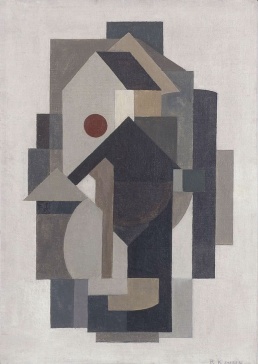
Several Norwegian painters got acquainted with abstract art during their studies under Fernand Léger and Amedee Ozenfant at Académie Moderne in Paris between 1924 and 1931:
- Thorvald Hellesen, in his 24 he moved to Paris, 1912. Hellesen's works at DigitaltMuseum.no, [23].
- Ragnhild Kaarbø lived in Paris throughout the 1920s; studied under Léger and Ozenfant in 1925-27. She took part in a number of exhibitions internationally, including the cubist one in Oslo in 1928. After her return to Oslo in the late 1920s she returned to Impressionism. Kaarbø's works at DigitaltMuseum.no, [24]
- Ragnhild Keyser. Keyser's works at DigitaltMuseum.no.
- Charlotte Wankel studied from 1910 at the well-established Académie Henri Matisse. From 1925 she took lessons from Léger. Wankel's works at DigitaltMuseum.no, [25]
Per Krohg, Akt [Nude], 1919. [1]
Picture, 1920. [2]
Komposisjon, 1920. [3]
Charlotte Wankel, Stående figur, 1926. [4]
Ragnhild Kaarbø, Komposisjon med hode, 1924-27. [5]
Ragnhild Kaarbø, Komposisjon, 1926-27. [6]
Jean Heiberg's bakelite telephone design
Jean Heiberg lived in Paris in 1905-12. He got acquainted with Fauvism and Cubism, and was the first of a number of Norwegian painters who studied under Henri Matisse (1908-10). He is also known for one work in industrial design: when he returned to Norway in 1929, he was commissioned to design a bakelite telephone terminal for Elektrisk Bureau (up till then, telephones had been made out of metal; bakelite was invented in 1909 by Leo Baekeland). Heiberg had produced the huge painted plaster prototype, however it proved to be too difficult to cast in bakelite; the later model had smooth surface and sharp edges. The phone went into production in 1932 as the Ericsson model DBH 1001, and is claimed as the world's first "hookless" bakelite telephone, that is the first telephone where the cradle, or receiver hook, was integrated into the all-bakelite body. The engineering design of this model was made by Johan Christian Bjerknes. The model was sold throughout Scandinavia, in Britain, Italy, Greece and Turkey, and (through Siemens) in France and the USA; staying in production for over twenty years. See also 25 min documentary from Arte TV. [26] [27] [28] [29]. Heiberg's works at DigitaltMuseum.no.
Metal prints and Snegrafikk of Rolf Nesch
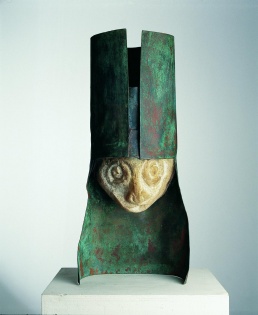
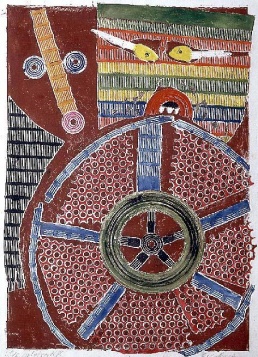
Rolf Nesch. Born in Germany, he moved to Norway following the Nazi takeover in 1933. Inspired by Norwegian scenery and working life, he discarded canvas and paintbrushes [30] for good, and turned to printmaking. He developed his own techniques for metal prints [31] and so-called Snegraffik [material pictures] [32], for which he used a range of materials: metal plates, copper wire, wood, stone, glass, mica, rope, nails, and so on. His metal prints include Elbe Bridge I (1932), Snow (1934) in a series of 20 (black and white), 21 metal prints of fisheries off the Lofoten Islands (1936) [33], 10 metal prints inspired by poems of Henrik Rytter (1937); the six-part Herring Catch (1938) inspired by the spring herring catch off Måløy; Beach Scenes (1939), a colour series of 18; and others. Material pictures [Snegrafikk]: Double Lion of Babylon (1934), Reclining Woman (1934), both large zinc plates with metal wire soldered to them; the three-part Music (1934-35); the high relief and abstracted figures of Peace (1935-36) whose theme is the 1915 Eastern Front; Lovers (1935-36). He also created distinctive sculptures, mostly figures in stone and bronze [34]. 1938 saw his first exhibition of material pictures, held at the premises of Kunstnerforbundet in Oslo. Nesch's metal-plate technique is described by Sidsel Helliesen of the National Museum; Eivind Otto Hjelle writes about his material pictures.
Events
- Exposition Internationale L'Art d'Aujourd'hui exhibition, Paris, December 1925. Exhibiting artists included Ragnhild Keyser, Charlotte Wankel, as well as other Scandinavian artists (Otto Carlsund, Waldemar Lorentzon, Vera Meyerson, Bengt Österblom, Franciska Clausen). [35]
- Exhibition at the Galerie d'Art Contemporain, Paris, June 1926, with paintings by Kaarbø, Keyser, Carlsund and Clausen. [36]
- Major exhibition at the Galerie Aubier, Paris, March 1927, with works by Kaarbø, Carlsund and Clausen. [37]
- Otte skandinaviske kubister [Eight Scandinavian Cubists] exhibition, Kunstnerforbundet [Artists' Association], Oslo, 1927. Kaarbo and others. Met with bewildered reactions from art critics calling for boycott of the Association.
- Unionalen exhibition in a dismantled bank building in Oslo, 1928. (See below).
- Kurt Schwitters in Norway between January 1937. The same year he started a second Merzbau in Lysaker near Oslo, but abandoned it in 1940 when the Nazis invaded. It was subsequently destroyed in a fire in 1951. His hut on the Norwegian island of Hjertøya, near Molde, is also frequently regarded as a Merzbau. For decades this building was more or less left to rot, but measures have now been taken to preserve the interior. The book Schwitters in Norway was published in 2009 (see below). Since 2010, Henie-Orstad Art Centre hosts the Kurt Schwitters room, being the largest permanent presentation by the artist's works outside Germany.
- Female Pioneers - New Voices exhibition at Lillehamer Kunstmuseum, 2013. With works by Keyser and Wankel.
Initiatives
- Unionalen (1926-31), an association of Scandinavian artists, primarily students of Henri Matisse, who returned from their stay in Paris. "The Maison Watteau academy in Paris had became an important meeting place both for Scandinavian and international avant-garde artists after World War I. When the Parisian art market collapsed in the late 1920s several Scandinavian artists decided to return to their respective countries. However, they wanted to hold on to the 'Parisian experiences'. Hence, the Unionalen was invented to be an ambulant Scandinavian substitute to the Paris node. Unionalen was initiated during a gathering in Henrik Sørensen’s studio in Paris in 1926. The main idea was to establish a continuation of the artist community and network in Paris through more or less casual events. Nils Dardel designed the flag of Unionalen with yellow, red and blue dices on white background to be hoisted in front of the entrance on each venue. The first show opened in Stockholm, 1927, the next in Oslo, 1928, and the last and most successful at Charlottenburg in Copenhagen in 1931, with more than 20 000 visitors. The artists behind the drive insisted on an international and open attitude and hoped also to produce an event in Paris. This became impossible because of political reasons." (from Kari Brandtzæg's paper abstract [38]).
- During the occupation of Norway by Nazi Germany, Jean Heiberg and Axel Revold were fired from their professorships at the Norwegian National Academy of Fine Arts in autumn 1941. Eventually they secretly started running an undercover art academy in Oslo, called Fabrikken [The Factory], as its first location was in a closed corset factory Norena (at Pilestredet 15). They were later located at Lauritz Falk's home at Frogner, at Johannes Sejersted Bødtker's studio at Holmenkollen, and in autumn 1944 in a warehouse in Thereses gate.
- Nordic Network of Avant-Garde Studies, research project started in 2004 with the aim to produce a series of four international conferences on Nordic avant-garde art, each to be followed by a book. The first was dedicated to analysis of the period 1900-25 and was held in Copenhagen in 2009 (with a volume published in 2012, see below); the second one (1925-50) is to be held again in Copenhagen, in October 2013.
Literature
- Unionalen 5-27 februari 1927, Stockholm: Liljevalchs konsthall, 1927, 39 pp. Catalogue.
- Harald Hansen (ed.), Unionalen: Stockholm, Oslo, København, Copenhagen, 1931, 91 pp.
- Hilde Mørch, Tre norske avantgardekunstnere i 1920-årene. Ragnhild Keyser (1889–1943), Ragnhild Kaarbø (1889–1949), Charlotte Wankel (1888–1969), Oslo, 1993. Dissertation. (in Norwegian)
- Karin Orchar (ed.), Schwitters in Norway, Hatje Cantz, 2009, 212 pp. ISBN 978-3-7757-2420-3. (in English and Norwegian). With texts by Karin Hellandsjø, Karin Orchard, Isabel Schulz, Terje Thingvold, and Sverre Wyller. Excerpt. [39] [40]
- Per Bäckström, Bodil Børset (eds.), Norsk Avantgarde, 2011, 790 pp. ISBN 9788270996490. (in Norwegian) [41]
- Tania Ørum, Ping Huang, et al. (eds.), A Cultural History of the Avant-Garde in the Nordic Countries 1900-1925, Amsterdam/New York: Rodopi, 2012, 680 pp. ISBN 978-90-420-3620-8. [42], Preview, Review.
- Frank Claustrat, "Nordic Writers and Artists in Paris Before, During and After World War I", pp 129-146. [43]
- Ellef Prestsæter, "The Avant-Garde as Network. Interview with Tania Ørum", Kunstkritikk, 23 April 2012.
- Kari Brandtzæg is currently writing her dissertation at the University of Oslo on aesthetics and politics in the inter-war period, investigating the international orientations among Norwegian socially engaged artists in the 1920s and 30s. [44]
- Line Ulekleiv (ed.), Kvinnelige pionerer - Nye stemmer, Lillehammmer: Lillehammmer Kunstmuseum, 2013, 20 pp. Catalogue.
- Hilde Mørch on Ragnhild Keyser.
Experimental film
- Literature
- Gunnar Iversen (ed.), Estetiske teknologier 1700-2000, Vol. 3, Scandinavian Academic Press, Oslo, 2006. ISBN 9788230400173. [45]
Action art, Happenings, Intermedia
- Gruppe 66
Situationist-influenced Gruppe 66 made some of the first action art and happenings in Norway. Its events saw a mix of poetry, new music, jazz, films, Co-ritus, concrete music, Laterna Magica shadow and puppetry theatre performances using light projection and slides, and participatory events. The group was inaugurated at a "living" exhibition in March 1966 [46], followed by another ground-breaking exhibition Konkret Analyse in 1970, both at Bergen Fine Art Association [Kunstforeningen]. The latter exhibition also involved public debates with politicians.
- Gruppe Lyn
In 1971, Gruppe 66 members were among the founders of Gruppe Lyn. This group presented their works in Oslo Fine Art Society in 1972 – an exhibition that attracted attention and was seen as a breath of fresh air and radically new in the Oslo area. Gruppe Lyn was a pragmatically oriented group without a shared philosophy, founded by Bård Breivik, Stein Rønning, Gerhard Stoltz, Bjørn Krzywinski, Birger Larsen and Arvid Pettersen. They shared workshops and studios and ran the self-organised Galleri 1, later known as Hordaland Artist Centre. (Source).
- Samliv exhibition
A group of artists from Bergen, centred around former members of Gruppe 66, initiated a grand collaborative project that aimed to ask, and answer, all of the taboo questions around sexuality, gender, sexual and reproductive health, pornography and sexual politics. Working with medical students, art students, and radical social theorists of all kinds, they produced an 'information exhibition', Samliv. The exhibition opened at Bergen Fine Art Association in 1977 and toured to Tromsø and to Kunstnernes Hus in Oslo. It was both highly controversial, and highly successful, with over 70,000 visitors. (Source).
- Other groups and artists
The Finnegård circle, the West Norway Art Academy, the Artists' Centre, the free textile artists, Wencke Mühleisen. Several Norwegians artists also participated in the Situationist group Drakabygget in Sweden.
Literature
- Olav Herman Hansen, "Gruppe 66", Kunst Plus 1 (2011), pp 4-7. (in Norwegian)
- Knut Ove Arntzen, "Gruppe 66, Co-ritus og kunsten som samhandling", Kunst Plus 1 (2011), pp 8-11. (in Norwegian)
Geometric abstraction, Neo-constructivism, Op art, Kinetic art
Venues
From the mid-1960s the optical and kinetic forms of expressions were shown at the Kunstnernes Hus in Oslo, particulary during the short-lived chairmanship of the leading experimental, radical left-winger Morten Krohg (1967-69), and at the Henie-Onstad Art Centre at Høvikodden which opened in 1968.
Artists and works
- Odd Tandberg was the first in Norway to try to create mobile visual images using electric motor-driven plastic and glass elements.
- Siri Anker Aurdal's neo-constructivist sculptural/social space was presented in 1968; to be reconstructed in 2013 for an exhibition in Stavanger [47].
- Irma Salo Jæger's geometrical installations of polaroid and refractive materials moved the multi-coloured light (Kunstnernes Hus, May 1968). In April-May 1970, her commission, kinetic sculpture Blikk [Glimpses], which used computer-controlled light and lasers, and was made in collaboration with the composer Sigurd Berge and the author Jan Erik Vold, was shown at Høvikodden (Berge's electronic composition was released in 2010, see below). The multimedia piece was so complicated to produce that the engineers Halvor Heier, Birger Komedal & Harald Schiøtz was hired for technical assistance.
- Anders Kjær and Kåre Kolberg's multimedia installation Nova was presented in the Studio Hall at the Henie-Onstad Art Centre in August 1972. One of Norway's first sound installations. It included a specially designed light show and music played from tape - blended together with a 13x19 metre installation consisting of glass, rubber tires and piles of paper that the audience could walk through. The composition was released as a CD in 2009 (see below). [48]
Computer and computer-aided art
- Blikk [Glimpses] by Irma Salo Jæger, Sigurd Berge and Jan Erik Vold, 1970. (See above)
- Keiserens Nye Slips [The Emperor's New Tie] by Kåre Kolberg, 1973. This piece by an electroacoustic music composer was commissioned by Fylkingen, Stockholm. It was composed and recorded in 1973 at Electronic Music Studios in Stockholm, using a PDP 15/40 computer, and was programmed in EMS-1 computer language developed in the same studio.
- Rolf Aamot's computer paintings, 1980s.
Video
- Rolf Aamot created many works for television in the 1960s-80s.
- Arne Nordheim created a number of works for television, in collaboration with Per Kleiva and Rolf Aamot, and Norwegian Broadcasting Bureau technicians and directors such as Ole Henrik Moe, Stein-Roger Bull and Rolf Clemens.
- Events
- Arne Nordheim in the World of Art: No "-Isms" for Me, Please! exhibition, Henie-Onstad Art Centre, August 2013-January 2014. Curator: Lars Mørch Finborud.
- Releases
- Arne Nordheim, Selected Works for Television 1967-1974, Prisma Records (PRISMADVD002), DVD, 2013. Contains Evolution, 1967 (with Rolf Aamot), and Greening, 1974 (with Per Kleiva and The Oslo Philharmonic Orchestra). [49], [50].
- Literature
- Lars Mørch Finborud (ed.), Arne Nordheim, ingen -ismer for meg, takk!, Oslo: Orfeus, 2013. ISBN 9788293140252. [51]
- Resources
- Videokunstarkivet, Norwegian video art archive, run by Per Platou.
Electroacoustic and experimental music
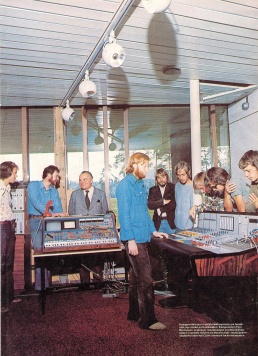
Composers
- Gunnar Sønstevold experimented with electronic instruments in his music for Shakespeare's The Tempest at the Norwegian Theatre in 1957; adhered to Schoenberg's twelve-tone technique.
- Arne Nordheim, Norway's most celebrated composer after Edvard Grieg.
- Rolf Aamot, electronic painter and tonal-image composer.
- Bjørn Fongaard, known for his works for a specially designed 'micro-intervallic' guitar.
- Sigurd Berge
- Kåre Kolberg created a computer music piece in 1973, among his other works.
- Hal Clark, founding director of Electronic Music Studio; lived in Norway throughout the 1970s.
- Knut Wiggen worked in Sweden; founding director of Stockholm's Electronic Music Studio.
Since the mid-1970s, composers John Persen, Tor Halmrast, Kjell Samkopf, Nicolay Apollyon, Rolf Wallin, Cecilie Ore and Peer Landa and Ruth Bakke produced electroacoustic works. Only a few of their works are purely electroacoustic. [52]
Younger generation include Arne Hellan, Anders Vinjar, Bjarne Kvinnsland, Ida Heidel, Ragnhild Berstad and Asbjørn Flø. [53]
Initiatives
- The Norwegian section of the International Confederation of Electroacoustic Music (NICEM).
- Norwegian Center for Technology in Music and the Arts (NOTAM), established in 1992. Until 2008 it operated under the name Norwegian Network for Technology, Acoustics and Music.
Events
- Performances of Bjørn Fongaard's Uranium 235 for orchestra in Oslo and Reykjavik, 1965-66. None of the performances took place because the musicians were unable to read the notation (Fongaard was developing his notation system, inspired by modernists such as Hindemith, Schoenberg and Webern). This later led the composer to peform his music on specially designed guitar. See his page for more.
- Electronic music concert-series Elektrofoni, Henie-Onstad Art Centre, 1968-83.
- Haagen Ringnes’ TV-show Åpen Post on the subject popmusic in Autumn 1969 featured actress and singer Elisabeth Grannemann's parody performance which included throwing dishes and yelling, with direct reference to composer Arne Nordheim's music. The eventually resulted in a double-LP with avant-garde pop songs from five composers, entitled Popofoni (see below). More detailed account of the story, and another one in Norwegian.
- Week-long visit of John Cage in Oslo, November 1983. His stay was well documented in photo, video and audio recordings, he was interviewed by all the major newspapers, as well as by Eivind Solås for NRK Television. A special pamphlet was printed for the event, containing articles by amongst others Kåre Kolberg and Kjell Samkopf. Shortly after his stay the Norwegian journal of new music, Ballade, published a special Cage edition. Recordings of the event were published in 1984 as an unusual 10-tape suitcase John Cage in Norway. [54]
- John Cage: The Anarchy Of Silence exhibition, Henie-Onstad Art Centre, February-May 2010. A book with CD was published on the occasion. [55]
Studio
- Norwegian Studio for Electronic Music (NSEM), 1975-78. Founded by Hal Clark and Arne Nordheim at the Henie-Onstad Art Centre, while it was run together with the Music Academy, Norwegian Broadcasting Bureau (NRK), and Composers Union. As a result of controversy it moved to the Academy, and soon dissolved.
Releases
- Arne Nordheim, Contemporary Music From Norway, Philips (839.250 AY), LP, 1967. Compositions: Canzona Per Orchestra; Epitaffio Per Orchestra E Nastro Magnetico; Response I For Two Percussion Groups And Magnetic Tape. [56]. Epitaffio later appeared on Music Of Arne Nordheim, Decca (HEAD 23), LP, 1979, [57], and on Epitaffio / Doria / Greening, Aurora (NCD-B 4931), CD, 2000, [58].
- Bjørn Fongaard, Alfred Janson, Arne Nordheim, Musique électronique norvégienne, Philips (DSY 836 896), LP, 1968, [59]. Compositions: Nordheim's Epitaffio and Response I; Janson's Canon; Fongaard's Galaxe, op 46, 1966. UK version, Philips (4FE8002), 1968, [60]. US reissue, Limelight (LS 86061), 1970, [61]. [62].
- Bjørn Fongaard's composition Homo Sapiens appeared on the compilation Nordic Music Days 1968, Vol 3, EMI & Odeon, LP, 1969. [63].
- Arne Nordheim, Colorazione / Solitaire / Signals, Philips (845 005 AY), LP, 1969. Compositions: Colorazione; Solitaire; Signals. Realised at Studio Eksperymentalne, Warsaw. [64].
- VA, Popofoni, Sonet (SLP 1421/22), 2-LP, 1973. Contains tracks by Gunnar Sønstevold, Nordheim, Alfred Janson, Kåre Kolberg, and Terje Rypdal. "Holy grail of Norwegian free-jazz and electronic music." [65]. Reissued by Prisma Records (PRISMALP001), 2-LP, 2012, [66], [67].
- Arne Nordheim, Sigurd Berge, Bjørn Fongaard, Contemporary Music From Norway, Philips (6507 034), LP, 1973. Tracklist: Nordheim, Fem Osaka-Biter [Five Osaka Fragments]; Berge, Månelandskap [Moon Landscapes]; Berge, Munnharpe [Jew's Harp]; Fongaard, The Space Concerto For Piano And Tape; Berge, Humoreske [Humoresque]; Berge, Eg Beisla Min Støvel [I Harnessed My Boot]; Berge, Erupsjon [Eruption]. [68].
- Arne Nordheim, Electronic Music, Philips (6507 042), LP, 1974. Compositions: Warszawa, 1970; Pace, 1970; Lux et tenebrae, 1970 (concrete and electric sounds for Osaka Expo 70). Recorded at Studio Eksperymentalne, Warsaw. [69]. Reissued by Norwegian Composers (NC 3842), 1985. [70].
- Kåre Kolberg, Nova, Prisma Records (PRISMA CD705), CD, 2009. Contains Nova, 1972 (composed for a multimedia installation, see above). [74], [75].
- Arne Nordheim's Colorazione For Hammond Organ X-66, Percussion, Time-Delay, Ring Modulators And Filters (Version 1982) appeared on his Colorazione, Philips (410 470-1), LP, 1983. Realised with Eugeniusz Rudnik (effects) and Kåre Kolberg (hammond organ). [76]
- Arne Nordheim, Dodeka, Rune Grammofon (RCD 2030), CD, 2003. Contains 12 tracks. [77]
- Sigurd Berge, Early Electronic Works, Prisma Records (PRISMA CD708), CD, 2010. The disc contains previously unreleased pieces Eg beisla min støvel, Preludium, Ritual, Sørgemusikk, and Erupsjon; the musique concrète piece Delta, which Berge also used in a collaboration with the avant-garde jazz trio Svein Finnerud in 1970; and the excerpts from electronic music composed for the multimedia installation Blikk (see above). [78], [79], [80].
- Bjørn Fongaard, Elektrofoni: Works For Micro Intervallic Guitar 1965-1978, Prisma Records (PRISMA CD711), 3-CD & 5-DVD, 2010. [81], [82]. The Wire review.
- Rolf Aamot, Tonal Image Films 1968-1991, Prisma Records, CD, 2011. Works: Actio, 1980; Kinetisk Energi Part 1 & 2, 1968; Nordlys, 1991; Progress, 1972; Viisuelt, 1971. [83], [84].
- Kåre Kolberg, Omgivelser & Portando, Prisma Records (prismaCD714), CD, 2011. Contains two compositions: Omgivelser, recorded in Studio Eksperymentalne, Warsaw, 1970; and Portando, recorded at Henie-Onstad Art Centre Studios, 1987. [85], [86]
- Kåre Kolberg, Electronic Works 1970-1973, Prisma Records (PRISMALP002), LP, 2012. Contains three works: Nova, 1972 (composed for a multimedia installation, see above), Omgivelser, 1970, Keiserens Nye Slips [The Emperor's New Tie], 1973 (recording previously appeared on a 1980 compilation by Philips[87] and Kolberg's 1988 compilation by Aurora[88]). [89], [90].
- VA, I Want The Beatles To Play At My Art Centre, Prisma Records (P004), 2-LP, 2012. Contains compositions by Nordheim, Berge, Fongaard, Kolberg, Hal Clark, John Cage, Magne Hegdal and others. With a DVD. [91], [92], [93].
- Hal Clark, Electro-Acoustic Works 1974-75, Prisma Records (PRISMACD716), CD, 2013. [94], [95].
Literature and references
Interview with Hal Clark about the Electronic Studio and music scene in Norway of the mid-1970s, sound recording, KPFA, 52 min, February 1975.
- Hal Clark, The Norwegian Studio for Electronic Music: A Comprehensive Instruction Guide, Høvikodden: Norsk Studio for Elektronisk Musikk, 48 pp.
- Hal Clark, "The Norwegian Studio for Electronic Music", AES 50 (March 1975). [96]
- Jøran Rudi, "International Electroacoustics in Norway - This Site Under Construction", Contact! 9.2 (Spring 1996). (in English and French)
- Hal Clark, "Norges første lydstudio", in Høvikodden Live 1968-2007, 2007. (in Norwegian). Excerpt.
- "Various ‘Eh bien, la Norvège…’", Continuo blog, 14 September 2009.
- John Cage in Norway, Høvikodden: Henie-Onstad Art Centre, 2010, 64 pp. With a CD. Dedicated to Cage's visit to Oslo in November 1983. [97], [98], [99].
- Lars Mørch Finborud (ed.), Arne Nordheim, ingen -ismer for meg, takk!, Oslo: Orfeus, 2013. ISBN 9788293140252. With texts by Paal-Helge Haugen, Ole Robert Sunde, Ola Nordal, Maja S.K. Ratkje, Rob Young, Lars Mørch Finborud, Ingvild Krogvig, Asbjørn Tiller and Asbjørn Blokkum Flø. [100]
- Yrke: Komponist [Occupation: Composer], a documentary film about Arne Nordheim made by Istvan Korda Kovacs, 1 hour, 1974. Included on Arne Nordheim, Selected Works for Television 1967-1974, Prisma Records, DVD, 2013.
New media art, Media culture, Media theory
- Cities
Oslo, Bergen, Stavanger, Trondheim, Kvinesdal, Grenland, Barentsburg (Svalbard), Sandnes, Tromsø, Kirkenes, Rjukan, Grimstad, Kristiansand.
- Initiatives and groups
http://m-cult.net/?lang=en&page=actors
- Literature
- Björn Norberg, Jonatan Habib Engqvist, "The Nordic pioneers of New Media Art", Ars Hypermedia, 2009.
- PNEK, Overview of electronic arts in Norway, 2010.
- Gunnar Iversen (ed.), Estetiske teknologier 1700-2000, Vol. 2, Scandinavian Academic Press, Oslo, 2004. ISBN 9788230400012. [101]
- Norsk Medietidsskrift journal. [102]
- Resources
- New media art in Norway - Overview
- Nor Noise – 12 Portraits about Noise Music, documentary film by Tom Hovinbøle.
- Media scholars
| Countries avant-garde, modernism, experimental art, media culture, social practice |
||
|---|---|---|
|
Albania, Argentina, Armenia, Australia, Austria, Azerbaijan, Belarus, Belgium, Bosnia and Herzegovina, Brazil, Bulgaria, Central and Eastern Europe, Chile, China, Croatia, Cyprus, Czech Republic, Denmark, Egypt, Estonia, Finland, France, Georgia, Germany, Greece, Hungary, Iceland, India, Indonesia, Iran, Ireland, Italy, Japan, Kazakhstan, Kosova, Latvia, Lebanon, Lithuania, Luxembourg, Malta, Mexico, Moldova, Montenegro, Morocco, Netherlands, North Macedonia, Norway, Pakistan, Peru, Poland, Portugal, Romania, Russia, Serbia, Spain, Slovenia, Slovakia, South Korea, Sweden, Switzerland, Turkey, Ukraine, United Kingdom, United States | ||
